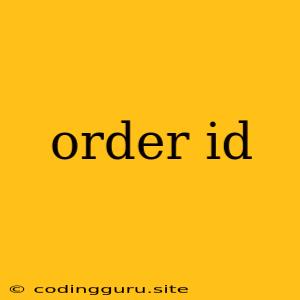Understanding and Managing Order IDs: A Comprehensive Guide
In the world of e-commerce, order IDs are crucial for tracking and managing customer orders. They act as unique identifiers, ensuring smooth transactions and efficient communication throughout the order lifecycle. Understanding how order IDs work, how they are generated, and how they are used is essential for both merchants and customers alike.
What is an Order ID?
An order ID is a unique alphanumeric code assigned to each individual order placed on an e-commerce platform. It serves as a primary key for referencing and identifying specific orders, allowing for seamless tracking from order placement to delivery.
Why are Order IDs Important?
Order IDs play a vital role in the e-commerce ecosystem:
- Order Tracking: Customers can use order IDs to track the progress of their orders, providing real-time updates on shipment status and estimated delivery dates.
- Customer Support: Order IDs enable customer support agents to quickly access order details, facilitate order modifications, address customer inquiries, and resolve issues effectively.
- Inventory Management: Order IDs help merchants manage inventory levels accurately by linking orders to specific products and tracking their availability.
- Financial Reconciliation: Order IDs are essential for financial reconciliation, ensuring that orders are accurately accounted for and that payments are processed correctly.
How are Order IDs Generated?
Order IDs are typically generated using a combination of:
- Auto-incrementing numbers: A simple and effective method, where each subsequent order is assigned a higher number than the previous one.
- Timestamp: Incorporating the current time and date into the order ID provides a unique identifier and facilitates chronological sorting.
- Random characters: Adding random letters or symbols increases the uniqueness and security of the order ID.
Best Practices for Managing Order IDs
- Unique and Sequential: Ensure that each order ID is unique and follows a logical sequence for easy tracking and reference.
- User-Friendly: Keep order IDs concise and easy to understand for both customers and internal staff.
- Secure and Encrypted: Implement strong security measures to protect order IDs from unauthorized access and prevent fraudulent activities.
- Comprehensive Database: Maintain a comprehensive database that stores all order IDs and their associated order details, providing a central repository for order management.
How to Use Order IDs Effectively
- Customer Communication: Include the order ID in all customer communication, including order confirmations, shipping notifications, and invoices.
- Order Management Systems: Integrate order IDs with your order management system to streamline order processing, inventory management, and fulfillment.
- Customer Support: Train customer support agents to effectively use order IDs to resolve customer queries and provide efficient service.
- Tracking and Reporting: Leverage order IDs to track key performance indicators (KPIs), analyze order trends, and improve business decisions.
Troubleshooting Order ID Issues
If you encounter issues with order IDs, such as duplicate entries or missing information, you can troubleshoot by:
- Reviewing your order ID generation logic: Ensure that the algorithm is generating unique and sequential order IDs.
- Checking your database: Verify that the order ID field is correctly configured and that all data is complete.
- Contacting your e-commerce platform provider: Seek assistance from technical support if you suspect an issue with the platform's functionality.
Example of an Order ID
Here's an example of a typical order ID:
ORD-20231027-1234567
This order ID consists of:
- ORD: Prefix indicating an order
- 20231027: Date of order placement (YYYYMMDD format)
- 1234567: Auto-incrementing number
Conclusion
Order IDs are essential for seamless e-commerce operations, providing a robust framework for managing orders, tracking customer purchases, and ensuring efficient fulfillment. By understanding the role of order IDs and implementing best practices for their generation and management, merchants can enhance customer experience, streamline business processes, and achieve greater success in the competitive e-commerce landscape.
